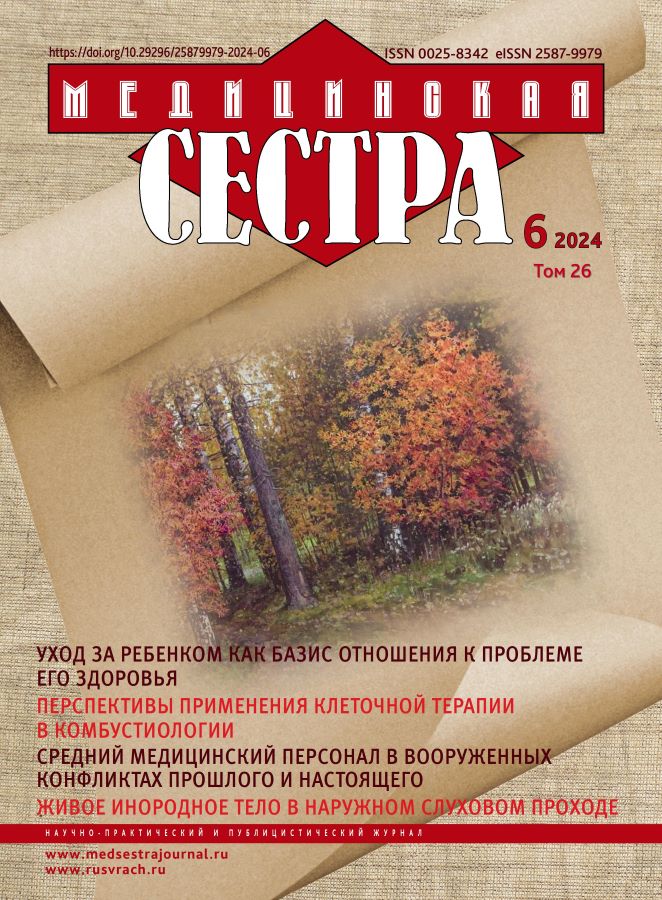Современные подходы к проблеме эпилепсии в практике медицинской сестры
- Авторы: Гулиян С.Г.1, Цецера Д.Э.1, Скворцов В.В.1, Родионова И.В.1
-
Учреждения:
- ФГБОУ ВО «Волгоградский государственный медицинский университет» Министерства здравоохранения Российской Федерации
- Выпуск: Том 26, № 6 (2024)
- Страницы: 42-45
- Раздел: Профессия: теория и практика
- URL: https://journals.eco-vector.com/0025-8342/article/view/636337
- DOI: https://doi.org/10.29296/25879979-2024-06-09
- ID: 636337
Цитировать
Полный текст
Аннотация
Основной принцип лечения эпилепсии – длительный регулярный прием противоэпилептических препаратов (ПЭП) для уменьшения частоты приступов или их полной редукции при отсутствии клинически значимых побочных эффектов. Своевременное выявление и коррекция побочных реакций – неотъемлемая часть лечения эпилепсии.
Ключевые слова
Полный текст
Об авторах
Сергей Геворгович Гулиян
ФГБОУ ВО «Волгоградский государственный медицинский университет» Министерства здравоохранения Российской Федерации
Email: serguliyan@gmail.com
студент
Россия, ВолгоградДиана Эдуардовна Цецера
ФГБОУ ВО «Волгоградский государственный медицинский университет» Министерства здравоохранения Российской Федерации
Email: diana.tsetsera@bk.ru
студентка
Россия, ВолгоградВсеволод Владимирович Скворцов
ФГБОУ ВО «Волгоградский государственный медицинский университет» Министерства здравоохранения Российской Федерации
Автор, ответственный за переписку.
Email: vskvortsov1@ya.ru
ORCID iD: 0000-0002-2164-3537
доктор медицинских наук, профессор кафедры внутренних болезней
Россия, ВолгоградИрина Викторовна Родионова
ФГБОУ ВО «Волгоградский государственный медицинский университет» Министерства здравоохранения Российской Федерации
Email: vskvortsov1@ya.ru
кандидат медицинских наук, доцент кафедры внутренних болезней
Россия, ВолгоградСписок литературы
- Vera-González A. Pathophysiological Mechanisms Underlying the Etiologies of Seizures and Epilepsy. Exon Publications. 2022; 1–13.
- Chen J. et al. Pathogenesis of seizures and epilepsy after stroke. Acta Epileptologica. 2022; 4: 1–6.
- Scheffer I.E., Berkovic S., Capovilla G. et al. ILAE classification of the epilepsies: Position paper of the ILAE Commission for Classification and Terminology. Epilepsia. 2017; 58 (4): 512–521.
- Vezzani A., Fujinami R.S., White H.S. et al. Infections, inflammation and epilepsy. Acta Neuropathol. 2016; 131 (2): 211–234.
- Chen, J., Ye, H., Zhang, J. et al. Pathogenesis of seizures and epilepsy after stroke. Acta Epileptologica. 2022; 4 (2).
- Husari K.S., Dubey D. Autoimmune Epilepsy. Neurotherapeutics. 2019; 16 (3): 685–702.
- Toledano M., Pittock S.J. Autoimmune Epilepsy. Semin Neurol. 2015; 35 (3): 245–258.
- Beghi, Ettore. The epidemiology of epilepsy. Neuroepidemiology 2020; 54 (2): 185–191.
- Sarmast S.T., Abdullahi A.M., Jahan N. Current Classification of Seizures and Epilepsies: Scope, Limitations and Recommendations for Future Action. Cureus. 2020; 12 (9): e10549.
- Scheffer I.E., Berkovic S., Capovilla G. et al. ILAE classification of the epilepsies: Position paper of the ILAE Commission for Classification and Terminology. Epilepsia. 2017; 58 (4): 512–521. doi: 10.1111/epi.13709. Epub 2017 Mar 8.
- Hirtz D., Berg A., Bettis D. et al. Practice parameter: treatment of the child with a first unprovoked seizure report of the Quality Standards Subcommittee of the American Academy of Neurology and the Practice Committee of the Child Neurology Society. Neurology. 2003; 60: 166–175.
- Hauser W.A. Should people be treated after a first seizure? Arch Neurol. 1986; 43: 1287–1288.
- Pohlmann-Eden B., Beghi E., Camfield C. et al. The first seizure and its management in adults and children. BMJ. 2006; 332: 339.
- Parkerson K.A., Pathmanathan J.S., Milligan T.A. Optimizing antiepileptic treatment. JCOM. 2009; 16 (10).
- St L., Erik K., Rosenfeld W.E. et al. Antiepileptic drug monotherapy: the initial approach in epilepsy management. Curr Neuropharmacol. 2009; 7: 77–82.
- Wheless J.W. A critical evaluation of midazolam nasal spray for the treatment of patients with seizure clusters. Expert Rev Neurother 2021; 21 (11): 1195–1205.
- Alvarez V., Lee J.W., Drislane F.W. et al. Practice variability and efficacy of clonazepam, lorazepam, and midazolam in status epilepticus: A multicenter comparison. Epilepsia 2015; 56 (8): 1275–1285.
- Trinka E., Kälviäinen R. 25 years of advances in the definition, classification and treatment of status epilepticus. Seizure 2017; 44: 65–73.
- Kapur J., Elm J., Chamberlain J.M. et al. Randomized Trial of Three Anticonvulsant Medications for Status Epilepticus. NETT and PECARN Investigators. N Engl J Med 2019; 381 (22): 2103–2113.
- Möddel G., Bunten S., Dobis C. et al. Intravenous levetiracetam: a new treatment alternative for refractory status epilepticus. J Neurol Neurosurg Psychiatry 2009; 80 (6): 689–692.
- Chamberlain J.M., Kapur J., Shinnar S. et al. Efficacy of levetiracetam, fosphenytoin, and valproate for established status epilepticus by age group (ESETT): a double-blind, responsive-adaptive, randomised controlled trial. Lancet 2020; 395 (10231): 1217–1224.
- Kim H.K., Lee H., Bae E-K. et al. Cardiac effects of rapid intravenous loading of lacosamide in patients with epilepsy. Epilepsy Res 2021; 176: 106710.
- Amengual-Gual M., Sanchez Fernandez I., Wainwright M.S. Novel drugs and early polypharmacotherapy in status epilepticus. Seizure 2019; 68 (3): 79–88.
- Fujikawa D.G. Starting ketamine for neuroprotection earlier than its current use as an anesthetic/antiepileptic drug late in refractory status epilepticus. Epilepsia 2019; 60 (5): 373–380.
Дополнительные файлы






